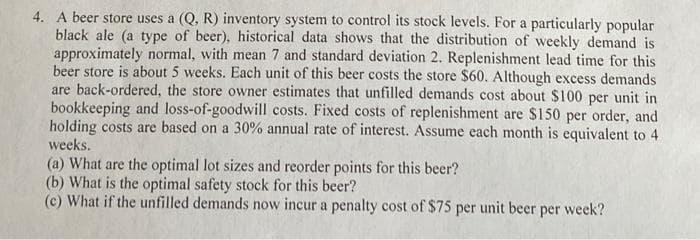4. A beer store uses a (Q. R) inventory system to control its stock levels. For a particularly popular black ale (a type of beer), historical data shows that the distribution of weekly demand is approximately normal, with mean 7 and standard deviation 2. Replenishment lead time for this beer store is about 5 weeks. Each unit of this beer costs the store $60. Although excess demands are back-ordered, the store owner estimates that unfilled demands cost about $100 per unit in bookkeeping and loss-of-goodwill costs. Fixed costs of replenishment are $150 per order, and holding costs are based on a 30% annual rate of interest. Assume each month is equivalent to 4 weeks. (a) What are the optimal lot sizes and reorder points for this beer? (b) What is the optimal safety stock for this beer? (c) What if the unfilled demands now incur a penalty cost of $75 per unit beer per week?
4. A beer store uses a (Q. R) inventory system to control its stock levels. For a particularly popular black ale (a type of beer), historical data shows that the distribution of weekly demand is approximately normal, with mean 7 and standard deviation 2. Replenishment lead time for this beer store is about 5 weeks. Each unit of this beer costs the store $60. Although excess demands are back-ordered, the store owner estimates that unfilled demands cost about $100 per unit in bookkeeping and loss-of-goodwill costs. Fixed costs of replenishment are $150 per order, and holding costs are based on a 30% annual rate of interest. Assume each month is equivalent to 4 weeks. (a) What are the optimal lot sizes and reorder points for this beer? (b) What is the optimal safety stock for this beer? (c) What if the unfilled demands now incur a penalty cost of $75 per unit beer per week?
Purchasing and Supply Chain Management
6th Edition
ISBN:9781285869681
Author:Robert M. Monczka, Robert B. Handfield, Larry C. Giunipero, James L. Patterson
Publisher:Robert M. Monczka, Robert B. Handfield, Larry C. Giunipero, James L. Patterson
Chapter16: Lean Supply Chain Management
Section: Chapter Questions
Problem 10DQ: The chapter presented various approaches for the control of inventory investment. Discuss three...
Related questions
Question

Transcribed Image Text:4. A beer store uses a (Q, R) inventory system to control its stock levels. For a particularly popular
black ale (a type of beer), historical data shows that the distribution of weekly demand is
approximately normal, with mean 7 and standard deviation 2. Replenishment lead time for this
beer store is about 5 weeks. Each unit of this beer costs the store $60. Although excess demands
are back-ordered, the store owner estimates that unfilled demands cost about $100 per unit in
bookkeeping and loss-of-goodwill costs. Fixed costs of replenishment are $150 per order, and
holding costs are based on a 30% annual rate of interest. Assume each month is equivalent to 4
weeks.
(a) What are the optimal lot sizes and reorder points for this beer?
(b) What is the optimal safety stock for this beer?
(c) What if the unfilled demands now incur a penalty cost of $75 per unit beer per
week?
Expert Solution
This question has been solved!
Explore an expertly crafted, step-by-step solution for a thorough understanding of key concepts.
This is a popular solution!
Trending now
This is a popular solution!
Step by step
Solved in 2 steps with 1 images

Recommended textbooks for you

Purchasing and Supply Chain Management
Operations Management
ISBN:
9781285869681
Author:
Robert M. Monczka, Robert B. Handfield, Larry C. Giunipero, James L. Patterson
Publisher:
Cengage Learning

Purchasing and Supply Chain Management
Operations Management
ISBN:
9781285869681
Author:
Robert M. Monczka, Robert B. Handfield, Larry C. Giunipero, James L. Patterson
Publisher:
Cengage Learning